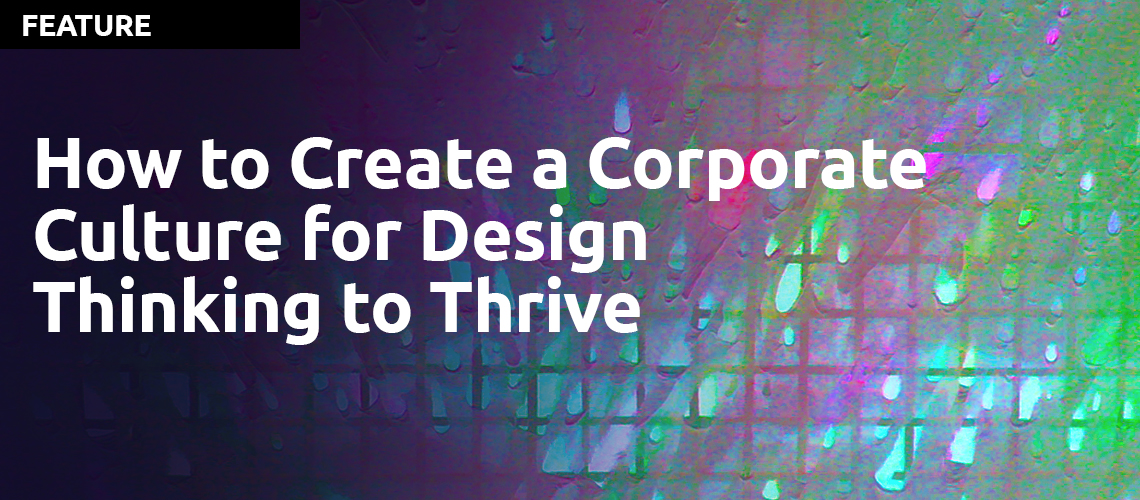
In our recent design thinking survey, one of the most difficult things respondents found about design thinking was integrating it into their corporations. When not supported from the CEO on down, design thinking is unlikely to create real change for a corporation and this manifests itself in many ways as we saw from the survey. Some of the top issues were executive buy-in, lack of time and resources to enable design thinking to have a really positive effect on a project.
Design thinking has rather different values and priorities as compared to a typical corporate culture measured in defined risk averse steps and it takes a different approach to typical corporate problem solving due to its focus on empathy with the end user, not an idea that is referenced much in the corporate ROI/Metrics/revenue growth/bottom line effects culture inherent to most corporations. An openness to fail fast and early and full collaboration between all players are all factors that do not resonate well or easily with most corporate cultures.
Hopefully you are starting to get the idea. If you are convinced that design thinking is important or even very important (87.3% of respondents) to your career success, and to your corporation or client (67.2%), then you will also be realizing that you will need a strategy and tactics to create a corporate culture for design thinking to thrive.
Skot Carruth of Philosophie has some good wisdom for you in his article How to Create a Culture of Design Thinking in which he references the corporations; Capital One (What's in your wallet?), Turner and GE. He says, "For design thinking to spread employees must be assured that they aren’t risking their reputations or careers by coming up with new ideas. Creating a culture of design requires companies to adopt four mindsets corporate-wide:
- Failure is part of the process - If failure is not acceptable, design thinking will not be acceptable.
- Exploration requires creative confidence - When a parent helps his infant swim by placing the baby in a pool, the child is given creative confidence. Your role in spreading design thinking should be to pull people into the design process who have never designed before. Be their coach.
- Everyone needs to play - instead of studying and discussing the insights (usual corporate culture behavior), push your executives to ideate and prototype solutions in a short period of time.
- Making is critical - Organizations tend to talk about metrics and strategy, but making is the essence of Innovation.
Nathan Owen Rosenberg of Insigniam has a lot of good advice to offer design thinkers as well. He looks at the obstacles in the way of implementing design thinking, suggests frameworks for deploying a culture change and talks about the nature of a corporate culture in his article Leading for a Corporate Culture of Design Thinking. Here are 3 corporate cultural forces that he discusses that undermine Design Thinking:
- Corporate Gravity - a hidden force that pulls your employees back to familiar ground—what is proven and known—rather than freely launching them toward innovation.
- Corporate Immune Systems - People will not make changes if they are threatened by those changes. People will rapidly adapt too and/or cause change when they can see an opportunity for themselves.
- Corporate Myopia - The power of design thinking is that it asks those engaged to think in different ways, That can be a problem for companies that are undergoing a transformation to design thinking while also operating an ongoing business.
Rosenberg says that "In the same way, design thinking cannot be embedded in a corporate culture without taking the time to build a stable base on which that change will rest." and he suggests the stable base should be 4 pillars of innovation:
- A leadership Mandate
- Dedicated Infrastructure
- Proprietary processes
- A Supportive Culture
Read his article (28.3 minutes). It is insightful and should leave you with a good framework to start your journey of culture change and provide good clues for you to start winning over the support of your CEO and executive team. Think of this as a journey, rather than an event and you will get your head into the right mindset. At the end of his article, Rosenberg suggests that there are 4 stages in moving a corporation through a cultural transformation: Reveal, Unhook, Invent, Implement.
There is a lot of good advice on cultural transformations on the web. The ones mentioned above relate directly to creating a design thinking culture or at least a culture receptive to design thinking. One final thought to leave you with would be to point you back to Tim Ogilvie's article How to Sell Design Thinking to your Boss. Tim suggests that like feeding your kids vegetables, don't mention that they are vegetables, just sneak them into the food they love (success, in your bosses case?). At some point they will ask how you do what you do - because you are creating so much value hopefully. If he/she does ask, then you will know its time to introduce them to the concept of design thinking!
Good luck on your journey.
